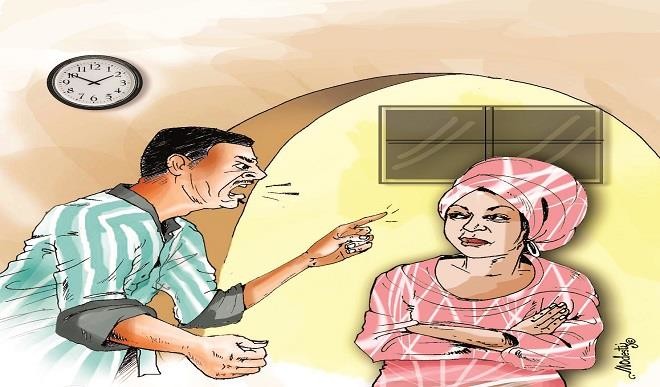The woman in the news
The scenes are familiar throughout Nollywood. After he’s cast away, Desmond returns successful (translation: rich). His community regrets having turned their backs on him kneels and begs his forgiveness. A friend lines up a group of beautiful, educated women so he can cherry-pick a bride. Desmond sends them away, gives money to the elders for […]


The scenes are familiar throughout Nollywood. After he’s cast away, Desmond returns successful (translation: rich). His community regrets having turned their backs on him kneels and begs his forgiveness.
A friend lines up a group of beautiful, educated women so he can cherry-pick a bride. Desmond sends them away, gives money to the elders for health centres, youth and women empowerment. His mother is the most important person in his life.
While he promotes the idea of women empowerment, he reinforces the power of men to make decisions. According to dominant masculinity standards, he is a "real man."
It is the image that’s stayed long in the Nigerian media industry and is growing stronger as the industry continues to shape perceptions and understanding of gender identities, religions and roles, according to new research by the Voices 4 Change.
It found the media "promotes male dominance and leadership and tends to underrepresent women in decision making and leadership."
It found more evidence in films and cartoons it analysed in a media study and less in news and advertisement.
The stereotypes of women seen in movies come across as "materialistic, fashion conscious and artificial," says Onazi Onazi.
The idea is that women are more concerned about superficial stuff: looks, hair, clothes, body image, how they are seen not heard.
"That’s what they see in movies, and they want to look like the stars and most times don’t understand it is not real," explains Onazi.
V4C describes the media–newspapers, TV, radio, films, comics–as one of the most important places for boys and girls, men and women to "learn to make sense of their world."
Yet news media also promotes male dominance by reinforcing traditional gender roles assigned to men and women, it adds.
News media describe men by using rational and profession-related adjectives and using personal and emotion-related adjectives for women.
The media mainly focuses on gender issues when covering women’s leadership news stories. V4C study found only one in six news articles explicitly mentioned gender issues, compared with 67 percent of articles on female leaders.
"This contributes to the common understanding that gender issues are mainly women’s issues," it said.
While men were more likely to be mentioned as leaders in business and politics, women were mentioned as leaders in fashion and jewelry and non-profit.
V4C said its media review "did not find a single reference to female leaders in education, religion, military, technology, agriculture and transport."
Men and women were more likely to equally lead in culture and arts as well as in entertainment and media.
Media makes effort to create programming aimed at promoting gender equality but the professionals themselves are constrained from promoting gender-equitable masculinities because of sexism in society and the media industry.
In newsrooms, men and women match by the numbers. But on editorial boards, which decide on content, men outnumber women nearly three to one, according to the research.
Male and female journalists and presenters are usually assigned different areas to cover depending on their sex. Women get women’s and children’s programmes and stories, men get coverage that may require working longer, later hours.
Said one media professional who participated in the study: "Working in production means you have to be extra strong because you work overnight and extra hours. It is not deliberate but men seem to be more suitable."
A news director said female reporters were assigned women affairs stories "in order to consider religious and cultural sensibilities of the community we serve."
Big is the widespread belief that content challenging gender stereotypes would not attract advertising revenue. The research found a number of programmes created to target men in a positive way never got off the ground because of lack of advertising support.
Meantime gender equality programmes and existing media regulation regarding gender issues are "more focused on women, actively excluding men as part of the discussion or as agents for social change," the research found.
A female student in Kaduna told researchers in participant interviews how media influenced her in a big way. Her career choice was decided by what she saw on TV. "I saw someone that I want to be like, and it has helped accelerate my life. And it has made me shortcut my life instead of going the point way," she said.
The role-model connection is one game the media plays big. Group study participants cited their role models to include Goodluck Jonathan, Barack Obama, Olu Jacobs and Ben Murray Bruce. They were mostly men who participants believe have exhibited positive gender or masculine values and who have been successful in their field of endeavours, the researchers explained.
Female role models cited include Christiane Amanpour, Omotola Jalade Ekehinde, Genevieve Nnaji, Ellen Sirleaf-Johnson, Funmi Akingbade who a Punch column on sex and relationships, and Folusho Alakija, who despite limited education became a fashion designer and one of the world’s richest women.
Researchers explained the female role models were chosen because they have overcome gender challenges, demonstrated strength of character, excelled in their careers and rendered gender-supportive services.
All are the images coming into living rooms, soaked up by growing boys and girls looking to make sense of their world.
